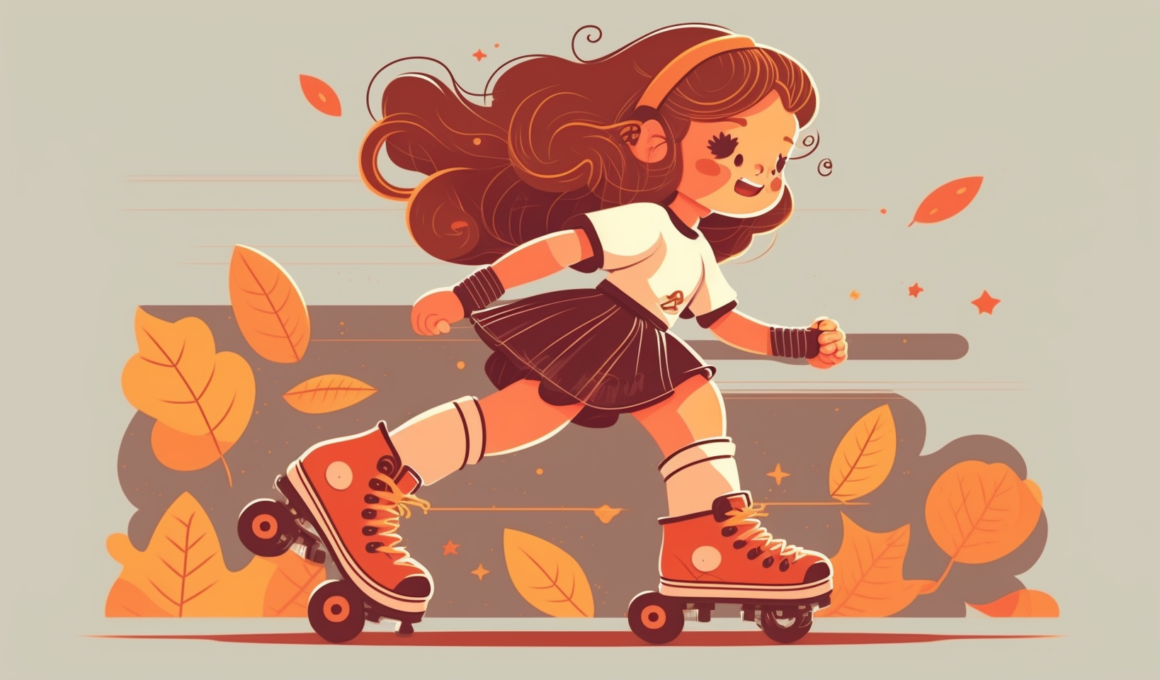Roller skating is a fun and exciting activity that has been enjoyed for generations. Whether you’re looking to learn the basics or master advanced techniques, roller skating can provide hours of entertainment and exercise.
But how long does it take to learn to roller skate? The answer might surprise you! In this blog post, we’ll break down the factors that affect learning to roller skate, provide a timeline for mastering different skills, and offer tips for successful learning. So grab your skates and let’s get rolling!
Factors That Affect Learning To Roller Skate
Age and physical ability, prior experience in other skating sports, quality and frequency of training, and safety gear and equipment are some factors that can affect an individual’s learning process of roller skating.
Age And Physical Ability
Age and physical ability are crucial factors that determine how long it takes to learn roller skating. Younger individuals and those with better physical capabilities tend to pick up the sport more quickly. However, age is just a number when it comes to learning roller skating as people of all ages can become proficient in the skill.
Prior injuries or disabilities may affect a person’s learning process, but this does not mean they cannot learn how to roller skate. It may take them longer than others, but with patience and dedication, anyone can master the technique. It’s important for learners of all abilities to consult their doctor before beginning any new physical activity such as roller skating.
Prior Experience In Other Skating Sports
Having prior experience in other skating sports can significantly affect how quickly someone learns to roller skate. For example, those who have already learned how to ice skate or inline skate may find it easier to balance on roller skates due to the similarities in technique and movement. However, it’s important to note that while some skills may transfer over, there are still unique challenges and techniques specific to roller skating that must be learned.
On the other hand, individuals with no prior experience in any kind of skating sport may take longer to learn the basics of roller skating as they’re starting from scratch. However, this does not mean that they cannot become good at it with time and practice. The key is for learners of all levels to commit time and effort into developing their skills on a consistent basis.
Quality And Frequency Of Training
The quality and frequency of training are crucial factors in learning how to roller skate. Regular practice sessions help learners build endurance, improve their coordination, and develop proper technique. To become a good roller skater, one needs to commit enough time to train regularly. According to our research, it takes anywhere from four to eight weeks with effort and commitment to become a good roller skater.
Furthermore, the quality of your training sessions also plays a significant role in your progress as a learner. Practicing on the right surface can make all the difference when learning how to balance and move forward on rollerskates. It is essential that you start practicing on flat surfaces before attempting more complex terrains like hills or slopes. Additionally, working with an experienced instructor or taking skating lessons can provide extra guidance on proper techniques, leading you toward becoming a better skater over time.
Safety Gear And Equipment
Safety gear and equipment are crucial when learning how to roller skate. The right gear can ensure that you stay safe while also giving you the confidence to try new moves. Some essential safety equipment includes a helmet, knee pads, elbow pads, and wrist guards. It’s crucial to choose high-quality gear that fits well and provides adequate protection for your skill level.
Another important factor is choosing the right type of skates for your needs. If you’re just starting out, it’s best to use quad skates as they provide more balance than inline skates. Additionally, make sure that your skates fit properly and offer good ankle support to prevent injuries. Remember, investing in quality safety gear and suitable skating equipment can help make your skating journey safer and much more enjoyable!
Timeline For Learning To Roller Skate
The timeline for learning to roller skate varies depending on the individual’s progress, but generally involves mastering initial basics in 1-2 hours, balancing and getting comfortable in 1-2 weeks and advanced techniques within 4-8 weeks. Want to know more about how you can become a good roller skater? Keep reading!
The Initial Basics: 1-2 Hours
Learning the initial basics of roller skating can take only 1-2 hours, but this varies depending on an individual’s natural ability to balance and coordinate their movements. During this stage, learners focus on getting comfortable with wearing skates, standing up straight, and walking around in them. They also learn how to move forward by pushing off one foot while gliding it alongside the other. Through consistent practice and repetition, these basic techniques can become more fluid.
In addition to mastering the simple mechanics of moving forward, beginners also need to learn how to stop properly during this introductory phase. A common technique is using a “T-stop,” where one foot is turned perpendicular across the other foot’s path to create friction that gradually slows down the motion until coming to a full stop. Once learners have gained confidence in performing these fundamental skills consistently without falling or injuring themselves, they can proceed confidently onto developing more advanced skating techniques over time.
Balancing And Getting Comfortable: 1-2 Weeks
During the second stage of learning to roller skate, learners begin to focus on balancing and getting comfortable with their skates. This period usually lasts between one to two weeks before learners can start moving forward confidently. At this stage, it’s essential to practice balancing exercises regularly so that you can develop a sense of stability on your skates.
It’s also important to invest in high-quality safety gear and equipment during this phase as falls are quite common. According to experts, starting on a flat surface is best for beginners since an uneven surface may cause imbalance leading to injury. The key here is patience – take small steps, be open-minded, embrace any mistakes or falls along the way and commit time every day towards perfecting balance until you get used to skating comfortably for longer periods.
Advanced Techniques: 4-8 Weeks
During advanced technique training, learners should focus on improving their speed and balance while incorporating different maneuvers. Learning how to turn, stop, and skate backward takes time and practice but can be mastered within 4-8 weeks with dedication. It’s essential to build endurance by skating longer distances each time you go out instead of remaining in the comfort zone.
Additionally, learning advanced techniques requires proper posture and footwork. To start moving at a faster pace or when doing tricks, one needs to shift their weight properly while balancing correctly on both skates. Endurance also plays an important role as good roller skaters need it for more prolonged practices without getting too tired quickly.
Skate parks are great venues for practicing advanced roller-skating techniques such as jumping up onto platforms or grinding curbs. With determination and perseverance during this stage of learning to skate, becoming a pro is achievable after only a few short weeks!
Tips For Successful Learning To Roller Skate
To ensure successful learning to roller skate, it’s important to have the proper gear and equipment, start on a flat surface, practice balancing exercises, take small steps, and embrace falls and mistakes – discover more by reading on!
Proper Gear And Equipment
When it comes to learning how to roller skate, having the right gear and equipment is crucial. Beginner skaters should invest in a good pair of skates that fit snugly but are not too tight or uncomfortable. Additionally, safety gear such as knee pads, elbow pads, wrist guards, and a helmet can help prevent injuries while learning.
It’s also important to choose the appropriate type of skates depending on where you plan to skate. For example, quad skating is best for indoor rinks while inline skating is better suited for outdoor surfaces. Lastly, make sure your skates are properly maintained by keeping them clean and tightening any loose screws before each use. With proper gear and equipment in place, beginner skaters can focus on mastering their technique without worrying about potential injuries or discomfort.
Starting On A Flat Surface
Starting on a flat surface is crucial for anyone who wants to learn how to roller skate. A smooth, level surface makes it easier for beginners to balance and glide without much effort. It’s best to practice in an empty parking lot, basketball or tennis court, or any other open space that provides enough room to move around comfortably.
When starting on a flat surface, make sure you wear proper gear such as a helmet and knee pads for safety. You should also start with small movements like walking in your skates instead of trying to take big strides right away. Taking small steps will help you develop balance while building up confidence on your skates. Remember that patience and practice are essential in learning how to roller skate properly.
Practice Balancing Exercises
Balancing is a crucial part of learning to roller skate, and it takes time and practice to get comfortable with it. To improve balance, there are various exercises you can do, such as standing on one foot for several minutes or practicing squats while wearing your skates. Regularly practicing these balancing exercises will help build the necessary muscle memory and increase your overall stability on skates.
Another great way to practice balancing is by using training wheels that attach to your skates. These tiny wheels provide extra support and help beginners feel more confident when trying out new moves. With consistent practice, you’ll be able to wean off the training wheels over time as you gain confidence in your balance skills.
Take Small Steps
When learning to roller skate, it’s essential to take small steps towards progress. Trying to do complex techniques too quickly can lead to frustration and discourage the learner from continuing their journey. Therefore, starting with simple basics such as balancing and moving forward is crucial for building a strong foundation.
Additionally, taking small steps also means being patient with oneself. Learning how to roller skate takes time, effort, and commitment. It’s okay not to get everything right on the first try or even after several attempts. Embracing falls and mistakes as part of the learning process can help build resilience while keeping a positive attitude towards growth. Ultimately, mastering roller skating requires consistent practice in taking small yet meaningful steps towards improvement.
Embrace Falls And Mistakes
Learning to roller skate isn’t always a smooth ride. Falling and making mistakes are part of the process. Instead of getting disheartened, it’s important to embrace falls and mistakes as they help you learn what not to do in future attempts.
Falling is inevitable when learning to roller skate, but wearing safety gear such as helmets, elbow and knee pads can prevent injuries. Frequent falling also helps build confidence in overcoming obstacles that may come your way while skating.
Making mistakes when learning how to roller skate is common too. It teaches you what works and what doesn’t work in various situations on skates. Remembering not to repeat the same mistakes will help you improve your skills faster so you can become a good roller skater in no time!
How Long Will It Take for My Kid to Learn to Roller Skate?
Teaching a child to roller skate can take anywhere from a few weeks to several months, depending on the child’s natural ability and practice frequency. Some kids pick it up quickly, while others may need more time to feel confident on wheels. Patience and encouragement are key during this learning process.
Conclusion: The Process Of Learning To Roller Skate Takes Time, Patience, And Dedication
In conclusion, learning to roller skate can be a fun and fulfilling activity that anyone of any age can enjoy. While some may learn faster than others, it’s important to remember that the process takes time, patience, and dedication.
By starting with the basics and practicing regularly while using proper gear and equipment in a safe environment, you’ll be on your way to becoming a skilled roller skater in no time. So what are you waiting for? Put on those skates, embrace falls and mistakes as part of the journey, and enjoy the ride!
FAQs:
1. How long does it generally take to learn how to roller skate?
The time frame for learning how to roller skate can vary depending on several factors such as your age, physical abilities, and level of commitment. However, most people can expect to spend at least a few weeks practicing before feeling comfortable on skates.
2. What are some tips for learning how to roller skate quickly and effectively?
Some useful tips that can help you master the basics of roller skating faster include wearing appropriate gear such as knee pads and helmets, practicing in a safe environment with smooth surfaces, starting small by practicing balance exercises or basic maneuvers like stopping and turning before progressing to more advanced techniques.
3. Can I learn how to roller skate on my own or do I need professional instruction?
While it is possible to learn how to roller skate on your own with enough practice, many people find that working with a professional instructor helps them accelerate their progress and avoid common mistakes that could lead to injury or frustration.
4. Is there any age limit for learning how to roller skate?
There is no specific age limit for learning how to roller skate – anyone who has the desire and ability can participate! However, it’s important for beginners of all ages – especially adults -to understand that there may be additional challenges associated with building strength and coordination required in skating compared with younger learners.




